| Pages:
1
2
3
4
5
..
10 |
Hey Buddy
Hazard to Others
  
Posts: 429
Registered: 3-11-2020
Location: Bushwhacker Country
Member Is Offline
|
|
Quote: Originally posted by Diachrynic  | | I'm curious for a proper writeup, since if you have NiCO3, you can make the acetate from it directly and use the preparation via that.
|
That is the beauty of it, AcO simply adds unnecessary ions and requires preparation from other precursor. CO3 leaves as CO2 and works directly. I
don't believe there is much benefit in yield from AcO vs CO3, possibly opposite. Regardless, because NiCO3 is readily available world wide as glaze
material, it can be bought as a cheap source of Ni ion, then used directly without conversion to NiAcO. (If one wants to avoid AcO preparation, that
is)
[Edited on 11-5-2023 by Hey Buddy]
|
|
|
MineMan
International Hazard
    
Posts: 1004
Registered: 29-3-2015
Member Is Offline
Mood: No Mood
|
|
What is the IPA method?
I think cooling speed is the best way to modify crystal size. Should be able to crash out in a few seconds and basically dust.
|
|
|
MineMan
International Hazard
    
Posts: 1004
Registered: 29-3-2015
Member Is Offline
Mood: No Mood
|
|
The acetic acid from the acetate helps the yield… for the copper complex the reaction will not work without the acetate. Maybe another acid can be
used, I don’t know.
|
|
|
Hey Buddy
Hazard to Others
  
Posts: 429
Registered: 3-11-2020
Location: Bushwhacker Country
Member Is Offline
|
|
Quote: Originally posted by MineMan  | What is the IPA method?
I think cooling speed is the best way to modify crystal size. Should be able to crash out in a few seconds and basically dust.
|
IPA instead of water as solvent. It increases yield but changes material. There doesn't seem to be much of a difference other than IPA makes powder
that is lighter colored vs darker crystals at lower yield with water. IPA or water solvent both explode at same velocity as far as I can tell. At
least enough to detonate secondaries. --The only thing I've changed from earlier methods is that I'm now boiling solvent first, then adding reactants
after boil is reached. Im doing that to control boiling times for record, so differences can be compared.
|
|
|
Hey Buddy
Hazard to Others
  
Posts: 429
Registered: 3-11-2020
Location: Bushwhacker Country
Member Is Offline
|
|
Quote: Originally posted by MineMan  | | The acetic acid from the acetate helps the yield… for the copper complex the reaction will not work without the acetate. Maybe another acid can be
used, I don’t know. |
In my opinion, acetates have been used because the acetate anion is soluble and doesn't complex. Nickel acetate isnt available as a commercial product
in quantity, and so it has to be prepared from a nickel source. In that case Nickel perchlorate could be prepared and used instead of the acetate. I
wasn't sure how a carbonate and bicarbonate would behave against a perchlorate but it works well. The metal carbonates are available in commercial
quantities because of the ceramics industries, so NICO3 for instance is available at as low as $15/lb, whereas acetate must be prepared or purchase at
premium. I can do a comparison between acetate and carbonate and perchlorate salts for yield, but in terms of efficiency and simplicity, its hard to
beat NiCO3.
|
|
|
Hey Buddy
Hazard to Others
  
Posts: 429
Registered: 3-11-2020
Location: Bushwhacker Country
Member Is Offline
|
|
NAP: NiCO3 procedure
I've conducted some tests on NAP production from NiCO3 and have drawn some conclusions. These are my findings. Hopefully free of errors...
This reaction has a lot going on, especially if other solvents are used besides H2O. I believe the solvents are all interacting with the reaction as
it takes on the complex. Excess ClO4 salt and Bicarb have been attempted in this effort to identify any differences, but it was found that ClO4 in
excess diminished yield and seemed to alter reaction route. Excess Bicarb results in a blackened solution which is variable with the amount of time in
boil. Too much boil time reduces product, too little boil time leaves reagents unreacted in solution. The black solution resulting from excess bicarb
typically has a metallic sheen on the surface like a bismuth rainbow, and has been described in the beginning of the thread with the original patent
procedure. That procedure uses > 2x excess AGu bicarb. The use of stoichiometric quantities in these reagents reduces the black solution and it
doesn't present itself in the same way when using this procedure.
Yield is ~.91 g which is low compared to other procedures, a 100% yield would be 2.96 g, but the simplicity of this procedure is the real advantage.
All of these reagents can be purchased or prepared in large quantity. In terms of crystal quality and consistency, I've found the stoichiometric ratio
of 1 AGu/1 ClO4/.5 Ni gives the best, consistent results. Yield can be increased around +40% from use of 91% isopropanol instead of water. Ethyl also
works with similar results, other solvents likely have effects on reaction, yield and product. IPA changes crystal morphology and end product color
but is still an effective explosive.
NAP 405.76 g/mol
NAP temp of explosive decomposition ~270 C
NAP can detonate as single crystals
I've found NAP to be more mechanically sensitive than ETN or SADS, but less sensitive than lead azide. I have found it to be more impact sensitive
than friction sensitive.
AGuHCO3 136.11 g/mol
NH4ClO4 117.49 g/mol
NiCO3 118.7 g/mol
The basic proportions are stoichiometrical and proportioned from AGu bicarb mass, which is considered as the critical reagent:
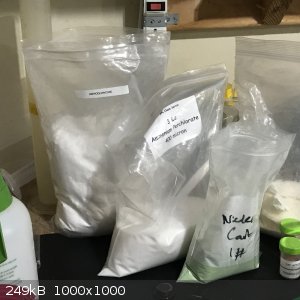
AGuHCO3 1.00 g
NH4ClO4 0.86 g
NiCO3 0.43 g
25 ml - 30 ml H2O are brought to a boil. If using a small diameter beaker, such as 2" diameter, then you can get away with 25 ml H2O. Larger diameter
beakers cook off water too quickly and need a greater starting water mass, something closer to 30 ml or even more depending on your beaker surface
area.
When water has achieved boil, all reagents are dumped in at once. The reaction turns lime green and begins to off gas NH3 and CO2 immediately. Some
foaming and rise in volume happens. The foaming subsides and the solution turns to a darker green. The total boil time is 7.5 minutes. I have tested
this procedure at 30 second boil intervals from 5 minutes to 15 minutes and have found in the case of H2O/IPA, 7.5 minutes boil to be the optimal in
resulting yield.
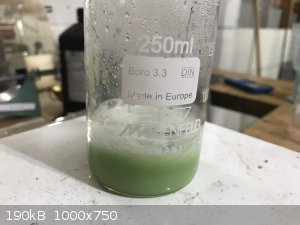
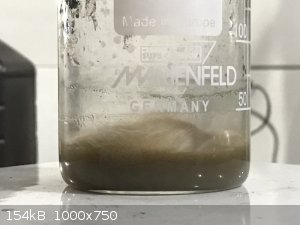
At the conclusion of the 7.5 minute boil, the reaction is removed from heat and left to cool at ambient temperature. If large red crystals are
desired, use H2O solvent and allow it to sit undisturbed during cooling. If small red crystals are desired, continue stirring throughout cooling. IPA
solvent will cool without stirring as a powder. Cooling is necessary only to near ambient temperature. Leaving the reaction to sit overnight in
solution decreases yield. Four hours is the patent recommendation, I have used an hour to around two hours of cooling before filtering. I have been
washing the material on filter only to the extent of rinsing out remaining material from the beaker with water and pouring this remainder and water
over the filtered crystals. I typically dry the finished material overnight at 60 C. NAP is still explosive when damp, but dampness reduces explosive
intensity and sensitivity.
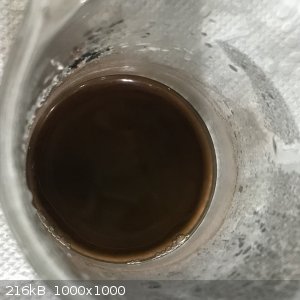 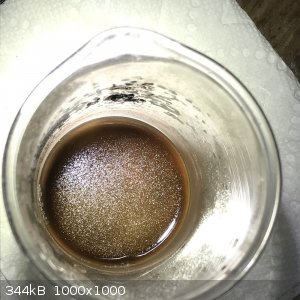 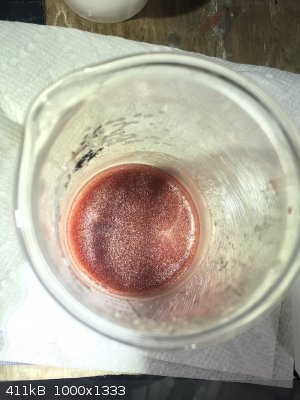 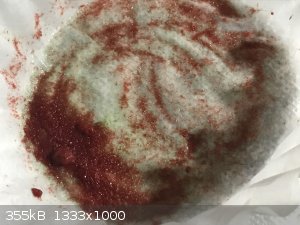
Overall I've found the complexation to be very sensitive to any change, with variable results, it certainly seems that IPA may be slightly less impact
sensitive than H2O solvent reactions. That is just speculation and needs further testing. It's still impact sensitive.
I purchased NiCO3 from Clay King in USA
https://www.clay-king.com/glazes_ceramic_pottery/raw-materia...
That price is average but i've since found it as low as $15/lb
AGuHCO3 was ordered through Alibaba
NH4ClO4 was ordered from pyrochemsouce
[Edited on 17-5-2023 by Hey Buddy]
[Edited on 18-5-2023 by Hey Buddy]
|
|
|
Laboratory of Liptakov
International Hazard
    
Posts: 1385
Registered: 2-9-2014
Location: Technion Haifa
Member Is Offline
Mood: old jew
|
|
Great detail science work, Buddy......
Development of primarily - secondary substances CHP (2015) Lithex (2022) Brightelite (2023) Nitrocelite and KC primer (2024)
|
|
|
MineMan
International Hazard
    
Posts: 1004
Registered: 29-3-2015
Member Is Offline
Mood: No Mood
|
|
Hey buddy. I think you’re using too much water. Water seems to destroy this compound
|
|
|
underground
National Hazard
   
Posts: 702
Registered: 10-10-2013
Location: Europe
Member Is Offline
|
|
So i guess the use of IPA solvent is the way to go since yields are increased.
Edit: Tetrazolover in his improved version use a mixture of AminogPerch and NiPerc
[Edited on 18-5-2023 by underground]
|
|
|
Hey Buddy
Hazard to Others
  
Posts: 429
Registered: 3-11-2020
Location: Bushwhacker Country
Member Is Offline
|
|
I assumed that water destroyed the complex too, but it's not that straight forward. The theory was that water destroys product and this is the black
color. By using proportional AGu, it eliminates this black liquid effect for the most part. Using 25 ml is based off of bringing the water to a boil,
then adding reactants. During the boil some of the water is lost. 25 ml starting volume, is enough to maintain a solution through the boil. 20 ml is
too little and will cause it to crystallize out of solution while heating on the hotplate. This effect is magnified if a wider beaker is used. At such
small volumes, minor changes, such as beaker surface area, have dramatic effect on the course of reaction. Even if the product jumps out of solution,
from evaporation of solvent, it is still useable, still explosive, but it changes the form of the material. By keeping it in solution, the form is
controlled and repeatable. I don't believe that the water is destroying the product. Water does seem to diminish product if the material is left in
solution for a long time.
|
|
|
Hey Buddy
Hazard to Others
  
Posts: 429
Registered: 3-11-2020
Location: Bushwhacker Country
Member Is Offline
|
|
Quote: Originally posted by underground  | So i guess the use of IPA solvent is the way to go since yields are increased.
Edit: Tetrazolover in his improved version use a mixture of AminogPerch and NiPerc
[Edited on 18-5-2023 by underground] |
I think the effect of solvent is interesting, but I'm not sure if it's necessarily better. It's a bit beyond my ability to analyze whats going on
accurately. I can only speculate. IPA does certainly increase yield, but it does alter the complex. In my opinion, consistent production of the same
product is more important than altering the material for yield. I also don't know the long term effect of IPA produced material, I have some in
storage for a month now, some in open air too. But will it last years? I dont know. Some other solvents may increase yield even further than IPA.
There are surely many tricks to increase yield. --From the start, AGu the limiting critical reagent. Preparation of other Ni substrates like acetate
or perchlorate is possible, but in my judgement, with the use of NiCO3, this primary explosive becomes easier to produce than even HMTD, or SADS
assuming that AGu preparation is done. It is definitely a magnitude simpler than azides by any route, and it outperforms azide in all categories in my
opinion. In the picture of the materials from post, it is basically all that's needed for several pounds of primary explosive, all the materials are
less practically hazardous than NaN3 or even concentrated H2O2. And they should be shelf stable for long duration. Maybe yields can be increased but I
think the simplicity outweighs the gain in yields from adding additional operations and effort, in my opinion that is.
|
|
|
MineMan
International Hazard
    
Posts: 1004
Registered: 29-3-2015
Member Is Offline
Mood: No Mood
|
|
Indeed. I don’t recall an issue with product forming too early with low volumes of water. But I do recall the best yields with less water.
Anyways. It’s time you explore the copper salt. More powerful and less sensitive.
|
|
|
MineMan
International Hazard
    
Posts: 1004
Registered: 29-3-2015
Member Is Offline
Mood: No Mood
|
|
If you add vinegar to replace some of your water my guess is you will see the yields increase.
|
|
|
Hey Buddy
Hazard to Others
  
Posts: 429
Registered: 3-11-2020
Location: Bushwhacker Country
Member Is Offline
|
|
It would be interesting to see character of other unknown metals. The patent only really describes Ni, Cu, and Co. Maybe see what it does with
cuprammine as a solvent? That would make for a simple prep. The ceramic stores seem to have a lot of carbonates which I would assume could just
replace Ni. Looking at them in another tab I'm finding Mn, Mg, Li, Sr, Ba.
|
|
|
MineMan
International Hazard
    
Posts: 1004
Registered: 29-3-2015
Member Is Offline
Mood: No Mood
|
|
I don’t know enough of why the metal anion makes such a difference, there must be a way to model this. I think some of the rare earths would be most
interesting. Dense and we are just finding their value in pyrotechnics, themrobarics and flare mixtures.
|
|
|
Hey Buddy
Hazard to Others
  
Posts: 429
Registered: 3-11-2020
Location: Bushwhacker Country
Member Is Offline
|
|
Update on IPA solvent NAP
6 month update:
Several samples of water solvent (W) NAP and IPA NAP were stored in sealed containers in a garage for 6 months. They were exposed to temps up to 95 F
(35 C) during ambient storage. One of the W NAP samples seemed to undergo a slight darkening to darker red color almost brown. That sample was tested
with a burn test and appeared to have weakened in explosive force. Another sample of W IPA did not appear to change color and that sample appeared to
have no changes over storage for 6 months on firing power. The IPA NAP sample had no change in appearance or firing power for 6 months.
I have been firing RDX caps with the IPA NAP at <10 mg with reliability. The IPA NAP also appears much less sensitive to hammer blow than the WNAP.
I dont have an apparatus to compare force, but from crude judgement, the IPA appears to detonate around the same hammer blow force as ETN, very close.
Due to the increased yield from IPA solvent, along with these obsevations, I think the IPA version may be more desirable over all. I am much more
confident pressing with the IPA variant over normal NAP due to apparent decrease in handling sensitivity. I have no idea what accounts for the
apparent desensitization. I thought at first it was morphology, but I now suspect the IPA complexes and it's a different molecule.
[Edited on 20-11-2023 by Hey Buddy]
|
|
|
B(a)P
International Hazard
    
Posts: 1139
Registered: 29-9-2019
Member Is Offline
Mood: Festive
|
|
Quote: Originally posted by Hey Buddy  | 6 month update:
Several samples of water solvent (W) NAP and IPA NAP were stored in sealed containers in a garage for 6 months. They were exposed to temps up to 95 F
(35 C) during ambient storage. One of the W NAP samples seemed to undergo a slight darkening to darker red color almost brown. That sample was tested
with a burn test and appeared to have weakened in explosive force. Another sample of W IPA did not appear to change color and that sample appeared to
have no changes over storage for 6 months on firing power. The IPA NAP sample had no change in appearance or firing power for 6 months.
I have been firing RDX caps with the IPA NAP at <10 mg with reliability. The IPA NAP also appears much less sensitive to hammer blow than the WNAP.
I dont have an apparatus to compare force, but from crude judgement, the IPA appears to detonate around the same hammer blow force as ETN, very close.
Due to the increased yield from IPA solvent, along with these obsevations, I think the IPA version may be more desirable over all. I am much more
confident pressing with the IPA variant over normal NAP due to apparent decrease in handling sensitivity. I have no idea what accounts for the
apparent desensitization. I thought at first it was morphology, but I now suspect the IPA complexes and it's a different molecule.
[Edited on 20-11-2023 by Hey Buddy] |
I have not tried your idea of using IPA as a solvent, though I did at one point compare filtering within an hour of reaction completion and leaving it
to sit overnight. For batches left sitting over night I found that the yield decreased and the product was not storage stable as you describe for you
(W) NAP. I observed the batches that were left over night to increase in volume over time, become less powerful and change/darken in colour to brown.
|
|
|
Hey Buddy
Hazard to Others
  
Posts: 429
Registered: 3-11-2020
Location: Bushwhacker Country
Member Is Offline
|
|
That is very interesting. In the brown sample in my case, it was filtered after an hour. Like I usually do and was beautiful red appearance. Browning
seemed to take place on that sample sometime during hot summer months.
Another thing about these AGu complexes in the patent, IIRC the cobalt complex cited was the Nitrate, not perchlorate. I missed this somehow, thinking
it was also the perchlorate. In that case, I may attempt some nitrates and check the cobalt perchlorate. I think zinc should be checked too. I dont
have any zinc carbonate. I do have some cobalt though... Has anyone attempted nitrates or other metal perchlorate analogues yet? I havent adventured
any further than the Ni so far.
|
|
|
Diachrynic
Hazard to Others
  
Posts: 226
Registered: 23-9-2017
Location: western spiral arm of the galaxy
Member Is Offline
Mood: zenosyne
|
|
In my experience, a sample, made as described on page one of this thread, that is from water, does not change at all for over three years. No change
in color or anything else, stored at ambient temperature.
I have prepared the nickel nitrate version, which is also a very nice red, with a different crystal shape. It is flammable, when heated it melts into
a brown liquid then burns, but nothing else was tested. The copper nitrate version was a pretty purple, which wasn't tested at all. They likely aren't
really energetic however. Alongside these I also made the nickel sulfate and copper sulfate version, but these are not energetic at all, obviously.
All of these are simple to prepare though.
The copper perchlorate version has been evaluated in this YouTube video by EnergeticHeretic: https://www.youtube.com/watch?v=YFO37dtkKEg
we apologize for the inconvenience
|
|
|
Hey Buddy
Hazard to Others
  
Posts: 429
Registered: 3-11-2020
Location: Bushwhacker Country
Member Is Offline
|
|
I found some Zn & Pb AcO also cobalt. Left is lead, pink is cobalt, salmon color is just an IPA NAP batch I needed to make for detonators and Zn
is on right. They appeared to successfully complex as they gave NH3 smell and precipitated product. I used water solvent for the experiments. Pb was
difficult to detect NH3 so it may not have complexed. Will find out soon. Will get back out tonight to try Ba(NO3)2 and Sr(NO3)2. Those are just
white, Id assume they will complex white. Will see...
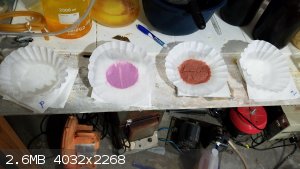
[Edited on 20-11-2023 by Hey Buddy]
Co AGu Perchlorate appears to be non energetic, which I find hard to believe. Suspect there may be issues with the cobalt source. Zn also doesnt seem
to fire much but Im waiting to dry overnight before more testing. Same with Ba/Sr nitrates. The nitrates do make some popping when wet which is good.
It's not as energetic as wet NAP, but will have to wait until dry before its character can be revealed. Pb seemed to react but it did not explode. It
appeared to turn to oxide on flame. Ba/Sr both fizzed and bubbled quite a bit on addition so Im hoping theres something energetic there.
Is calcium or potassium worth checking? They seem unlikely. Ca would probably be hygroscopic. K would probably not be energetic. Still, perhaps KClO4
test. If that could complex into a primary it would be pretty handy...
[Edited on 21-11-2023 by Hey Buddy]
What about Boric acid? I think boron can make some really strange complexes and boric acid is soluble in water.
[Edited on 21-11-2023 by Hey Buddy]
|
|
|
MineMan
International Hazard
    
Posts: 1004
Registered: 29-3-2015
Member Is Offline
Mood: No Mood
|
|
Curious for the boron!
|
|
|
Hey Buddy
Hazard to Others
  
Posts: 429
Registered: 3-11-2020
Location: Bushwhacker Country
Member Is Offline
|
|
Sr/Ba(AGu)2(NO3)2 are not energetic
Zn, Co(AGu)2(ClO4)2 not energetic
Pb appears to not have complexed and reverts to oxide. Will attempt to check KClO4, Ca ClO4 and Boron ClO4 hopefully today
Really wondering why there was no luck with Co. It should react to form an energetic syrup with either nitrate or perchlorate according to patent. I
used AAV1 method for all of these. I reviewed the Cobalt carbonate source. From ceramic supply store. Should be no issue even with trace mineral
contaminants. May repeat test with longer reaction time or different solvent...
[Edited on 21-11-2023 by Hey Buddy]
Ahh, I missed translation on patent. Filtrate of cobalt is concentrated to render syrup. I suppose the pink filtered material is inert discard.--Ni is
definitely looking to be preferable.
[Edited on 21-11-2023 by Hey Buddy]
Potassium and boron go into a transparent solution. only crystallize on refrigeration. Boron barely yields, not enough for practicality. Potassium
looks not energetic and turns orange color on burning.
[Edited on 22-11-2023 by Hey Buddy]
|
|
|
Microtek
National Hazard
   
Posts: 869
Registered: 23-9-2002
Member Is Offline
Mood: No Mood
|
|
I agree that it is almost inconceivable that Co(AGu)2(ClO4)2 should be non-energetic. One thing to test would be to convert the CoCO3 to perchlorate
via reaction with HClO4. That way you can be more confident that the recovered complex is not a carbonate based one...
|
|
|
Hey Buddy
Hazard to Others
  
Posts: 429
Registered: 3-11-2020
Location: Bushwhacker Country
Member Is Offline
|
|
Quote: Originally posted by Microtek  | | I agree that it is almost inconceivable that Co(AGu)2(ClO4)2 should be non-energetic. One thing to test would be to convert the CoCO3 to perchlorate
via reaction with HClO4. That way you can be more confident that the recovered complex is not a carbonate based one... |
Yes, apparently, It's in the filtrate. I shouldnt have wrote these are "not energetic". What I should have specified was "using method AAV1 from
patent, the apparent product for these attempts were non-energetic." There should be energetic products I think for the zinc and cobalt, but the
method used for NAP probably has to be altered to yield a product. On the cobalt, patent instructs boiling filtrate down to syrup. I suppose what was
recovered from filter in these cases is unreacted material.In that case, It's not as desireable to me as NAP because of the extra processing steps. I
think the only primaries more efficient in production are arguably SADS and Hg(CNO)2. NAP, especially in IPA solvent is so efficient, relative to
input operations and time, assuming AGu is already prepared, very efficient. IPA even decreases drying time relative to water. You can batch and fire
NAP in a couple hours.
[Edited on 22-11-2023 by Hey Buddy]
|
|
|
Microtek
National Hazard
   
Posts: 869
Registered: 23-9-2002
Member Is Offline
Mood: No Mood
|
|
Yes, NAP is very hard to beat. However, have you tried putting the finished NAP in water? I did that to see if recrystallization was possible, and the
NAP was destroyed over the course of hours, producing more of the black solution.
|
|
|
| Pages:
1
2
3
4
5
..
10 |